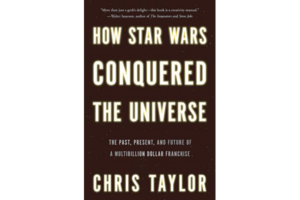'How Star Wars Conquered the Universe' explains (very astutely) how a series of films became a mythos
A long time ago, a galaxy far, far away proved to be immensely lucrative.

How Star Wars Conquered the Universe: The Past, Present, and Future of a Multibillion Dollar Franchise
By Chris Taylor
Basic Books
488 pp.
The "Star Wars" universe is absolutely gill-packed with enough material to do your head in, even if you’re the sort who begins planning what expanded universe character you’re going to dress up as for Halloween around Memorial Day. There are the films, and there is the culture, and the former have often been outstripped by the latter. Chances are, you think of "Star Wars" as collective intergalactic “things” – possessed of "Star Wars"-ness, as you do a set of films. Which can be both fascinating and confusing. Enter, then, docent to this universe, Chris Taylor.
How Star Wars Conquered the Universe: The Past, Present, and Future of a Multibillion Dollar Franchise offers astute commentaries on how the movies were made – and yes, that includes the prequels – along with sidebars looking at what some will surely deem kitsch culture, those freaks and geeks – in the kind, cuddly sense – of "Star Wars" fandom who do all sorts of things that simultaneously boggle the mind, arch the eyebrow, and cause laughs or consternation.
There’s an emphasis on fun here, but Taylor – who understands the workings of these films and the concomitant business culture that springs from them, without feeling overtly business-y – shows just how that guy who spends a decade of his life and thousands of dollars constructing an R2-D2 costume is exactly the kind of guy who turns one great film, an overrated follow-up, a solid third outing, and three dreckish affairs, into a mythos.
For all of the ancillary texts and products that have emerged around "Star Wars," the genesis of that mythos in actual moviemaking remains fascinating – and Taylor, strange as this may sound, is simply better at watching "Star Wars" films than most people. His breakdown of what George Lucas viewed as the crucial first ten minutes of the original picture is a master class in film criticism, friendly bar stool chatter, and modern visual history, even. How our collective pop culture eye works, you might say. And while our sense, as viewers, is that that opening Empire vs. rebels chase sequence goes on for minutes, with the mind-blowing “no way” shot of the baddies’ Star Destroyer capping it off, we’d all be wrong, but that’s because the "Star Wars" universe does weird things with time. “In fact, the Star Destroyer shot lasts just thirteen seconds – less than half of the length of a TV ad,” Taylor writes. “But by the end of those thirteen seconds, the film has effectively established just how powerful and evil the Empire is, and just how overmatched the rebels are.”
And that’s the brilliance of that first film. Hitchcock called this “pure cinema,” and Taylor skillfully points out Lucas’s debt to silent films, to images giving you story, and, crucially for Lucas, editing giving you story. We venture back to 1973’s "American Graffiti," Lucas’s financial breakthrough, with Ron Howard making some comment about something or other looking amiss, and Lucas say, basically, don’t sweat that, this film is being made in the editing room. Bet you wouldn’t think of Lucas as some Eisenstein-ian collagist, but so he was, at least before CGI wrecked him or set him free, depending on which side of the blue screen of that argument you stand on.
The fishwives get their gossip, too, and there’s some drugging and inter-cast shagging and the tech guys like their porn, but what’s most surprising, perhaps, is that once you’ve read this book straight through, admiring a structure that can move from 1977 to some dude’s garage with his custom-made Storm Trooper uniform to a political ceremony a decade ago to "Family Guy," is that this might be the foremost "Star Wars" reference book, without trying to be a reference book. "Star Wars" reference books are big, because there is, simply, a lot of minutiae to keep track of, and if you think "The Walking Dead" breeds obsessions, that’s pop culture lite compared to the "Star Wars" behemoth. But they’re seldom readable. Taylor sucks you in repeatedly, and part of the pleasure is that even when he’s crunching the numbers of the "Star Wars" brand, there are enough asides and insights that even a long-time fan will be viewing at least that first film anew, and also running down various YouTube films, perhaps some old Lucas interviews, and assorted fan edits. Taylor even gets into the script drafts for what later became known as "A New Hope." “After a dinner of ‘thanta sauce’ and ‘bum-bum extract,’ Luke embarks on a long-winded, jargon-filled explanation to his younger brothers about the Force of Others,” Taylor details, before wryly adding, “there’s a lot of food in this draft.”
As for George Lucas: dead-interesting guy, and a likable, often conflicted, self-doubting guy in these pages, a guy not entirely unlike some of the "Star Wars" fans who rip him for a lot of what he’s perceived to have done to their beloved universe. He’s a film head in the extreme, and man who rewards überfans with, on occasion, jobs. Then again, alongside the exegeses on the popularity of Boba Fett, the argument that R2 is the real teller of these tales (after the fact), and accounts of people sleeping outside of theaters for barely believable amounts of time, there is a dossier on all things 1978 "Holiday Special." Which, if it doesn’t exactly provide balance to the universe, proves that Taylor has equanimity – which is kind of Force-like – behind him.

